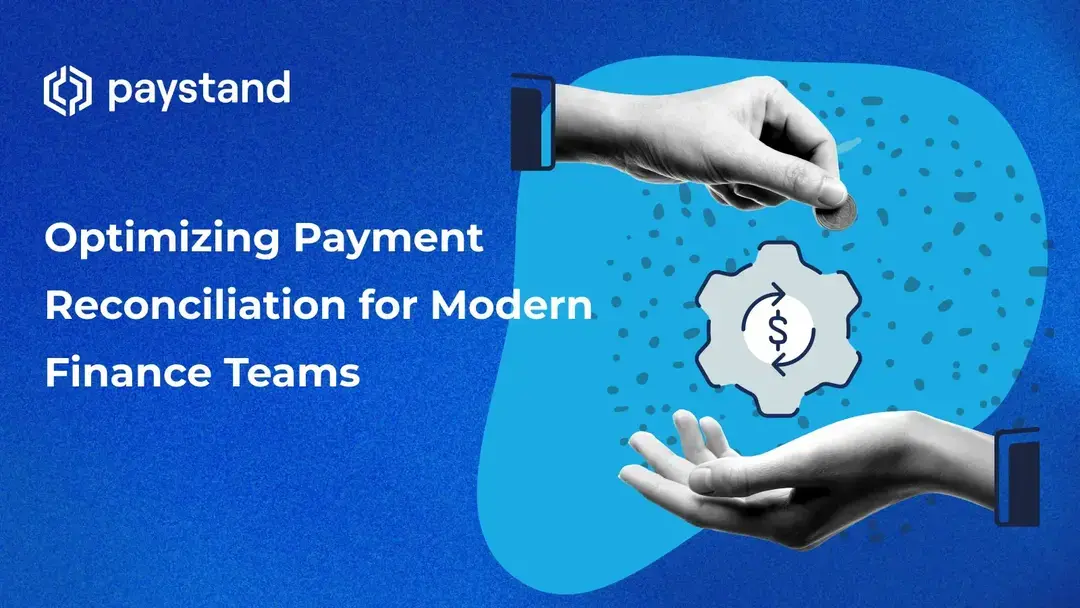Optimizing Payment Reconciliation for Modern Finance Teams

Table of Contents
- Understanding the payment reconciliation process
- The growing complexity of finance reconciliation
- How do you reconcile pay-later payments with invoices?
- The role of automated payment reconciliation
- Best practices for an effective payment reconciliation process
- Rethink your payment reconciliation strategy with Paystand
Key Takeaways
- Manual payment reconciliation is inefficient and prone to errors, especially as businesses scale and adopt multiple payment methods.
- The reconciliation process involves retrieving records, matching transactions, resolving discrepancies, and updating financial statements, but manual methods slow this down.
- Pay-later transactions add complexity to reconciliation, requiring automation to track outstanding invoices, integrate with AR systems, and prevent financial reporting delays.
- Automated payment reconciliation improves accuracy, reduces fraud risks, saves time, and seamlessly integrates with financial systems for scalability.
- Best practices for effective reconciliation include frequent reconciliation, automation, standardized documentation, discrepancy tracking, and system integration.
Payment reconciliation is a cornerstone of financial accuracy, yet many businesses still rely on time-consuming manual processes that create inefficiencies and risk errors. As companies scale and adopt multiple payment methods, these outdated reconciliation methods can no longer keep up. Automated payment reconciliation offers a smarter approach, improving accuracy and efficiency while freeing finance teams from tedious tasks.
Let’s explore the importance of payment reconciliation, its key challenges, and how accounts receivable automation transforms the process.
Understanding the Payment Reconciliation Process
At its core, payment reconciliation ensures that a company’s financial records align with bank statements. Every transaction should have a corresponding record, and discrepancies must be identified and resolved. Without a structured reconciliation process, businesses risk financial inaccuracies, missed payments, and even fraud.
The reconciliation process generally follows these steps:
-
Record retrieval: This is the foundation of the reconciliation process. Finance teams must gather all internal transaction records, including invoices, receipts, and payment confirmations. Additionally, they must retrieve external records such as bank statements, credit card transactions, and digital payment platform reports. The accuracy of reconciliation depends on having comprehensive, up-to-date records.
-
Matching transactions: Once records are collected, finance teams compare internal records with external statements to ensure each transaction has a corresponding entry. This step involves identifying payments that have cleared, flagging those still pending, and pinpointing any inconsistencies that need further investigation.
-
Reconciliation: When mismatches occur, finance professionals must determine the cause of the discrepancy. Errors can stem from duplicate transactions, incorrect payment amounts, delays in processing, or even fraudulent activity. Resolving these issues may require contacting banks, vendors, or customers to verify payments and correct errors.
-
Finalization: Once all discrepancies are addressed, financial statements and general ledger accounts are updated to reflect the company's accurate financial standing. This ensures the integrity of financial reports, making it easier to assess cash flow, budget effectively, and maintain compliance with regulatory standards.
Manual reconciliation requires painstaking data entry and verification, increasing the likelihood of mistakes and inefficiencies. As businesses scale, handling an increasing volume of transactions without automation becomes unsustainable. Implementing automated payment reconciliation can drastically reduce the time spent on these tasks while improving accuracy and financial visibility.
The Growing Complexity of Finance Reconciliation
As businesses expand, so does the complexity of finance reconciliation. Increased transaction volumes, multiple payment sources, and the adoption of digital and B2B payments all add layers of difficulty. Manual reconciliation simply cannot scale effectively, making errors and inefficiencies inevitable.
Companies that rely on outdated processes often face:
- Delayed financial closings due to the time required to match transactions.
- Increased error rates from manual data entry and oversight.
- Higher fraud risks caused by the slow detection of unauthorized transactions.
To mitigate these risks, businesses must modernize their reconciliation workflows with automation.
How Do You Reconcile Pay-Later Payments with Invoices?
The rise of pay-later payment options has added another layer of complexity to reconciliation. Unlike traditional payments, which are recorded immediately, pay-later transactions involve deferred payments that must align with invoices. Manually managing these transactions can create bottlenecks, increase error rates, and lead to delayed financial reporting.
To reconcile pay-later payments effectively, businesses should implement a structured approach:
-
Track outstanding invoices separately: Maintain a clear record of invoices linked to pay-later agreements. This helps finance teams distinguish between completed payments and pending amounts.
-
Use automation for real-time tracking: Automated payment reconciliation tools can track when pay-later payments are received and instantly match them with corresponding invoices. This eliminates the need for manual intervention and reduces errors.
-
Integrate with AR systems: Connecting reconciliation software with AR automation ensures that unpaid invoices are continuously monitored and updated once payments are received.
-
Regularly audit pay-later accounts: Periodic reviews help identify payment delays and potential disputes, ensuring businesses maintain healthy cash flow.
-
Implement notifications and reminders: Automated customer reminders about upcoming or overdue payments can minimize collection issues.
By automating bank reconciliation, companies can ensure these transactions do not create discrepancies in their financial records while improving overall cash flow management.
The Role of Automated Payment Reconciliation
Automation is transforming the payment reconciliation process, allowing businesses to streamline operations and enhance accuracy. Instead of manually cross-referencing transactions, automation tools handle reconciliation in real-time, flagging discrepancies instantly and reducing the time required for financial closings.
Here’s how automation enhances payment reconciliation:
- Faster fraud detection: Automated systems analyze vast transaction volumes quickly, identifying mismatches, unusual patterns, and potential fraud before they escalate into financial losses.
- Time and cost savings: Finance teams spend less time on manual reconciliation, reducing labor costs and increasing efficiency. Automation allows professionals to focus on strategic financial planning rather than transactional work.
- Improved financial transparency: Real-time reconciliation provides greater visibility into cash flow, allowing businesses to make informed financial decisions based on accurate, up-to-date data.
- Scalability for growing businesses: As companies expand and handle more transactions, automated reconciliation adapts effortlessly, ensuring accuracy without requiring additional manual effort.
- Seamless integration with financial systems: Automation tools integrate with ERP systems, accounting software, and payment platforms to create a unified financial ecosystem. This eliminates data silos and ensures all financial records are aligned across platforms.
- Reduction in reconciliation errors: Machine learning and AI-driven reconciliation tools continuously improve, learning from past discrepancies to minimize errors in future transactions.
For businesses aiming to optimize their financial workflows, investing in automated payment reconciliation is no longer an option, but a necessity.
Best Practices for an Effective Payment Reconciliation Process
To optimize the payment reconciliation process, businesses must adopt best practices that enhance efficiency, accuracy, and financial oversight. A well-structured approach ensures that errors are caught early, compliance is maintained, and financial statements accurately reflect company finances. Here are five essential strategies to refine your reconciliation process:
1. Reconcile Frequently
Performing daily, weekly, or monthly reconciliation enables finance teams to catch errors before they snowball into larger issues. The closer reconciliation occurs to the transaction date, the easier it is to track and correct discrepancies. Frequent reconciliation also ensures that financial reports remain up-to-date, reducing the risk of delayed decision-making caused by outdated records.
2. Leverage Automation
Manual reconciliation is not only time-consuming but also prone to human error. Implementing AI-driven and rule-based automation tools eliminates the need for manual transaction matching, speeds up the reconciliation process, and enhances accuracy. Automation tools instantly detect discrepancies and flag potential issues for review rather than requiring finance teams to sift through transaction records manually. Automated payment reconciliation minimizes compliance risks by maintaining a transparent audit trail.
3. Standardize Documentation
Consistent documentation is key to an efficient reconciliation process. Businesses should establish standardized formats for invoices, receipts, and payment records to ensure every transaction has a clear, verifiable paper trail. Details such as transaction IDs, timestamps, payment sources, and invoice numbers should be uniformly recorded. A well-documented financial system simplifies reconciliation and helps resolve disputes quickly.
4. Track and Analyze Discrepancies
Unresolved discrepancies can reveal inefficiencies, fraud risks, or gaps in financial controls. Maintaining a record of discrepancies enables finance teams to identify recurring issues, whether from a particular payment processor, vendor, or internal process. By tracking anomalies and reviewing trends, businesses can refine their reconciliation processes, enhance fraud detection, and improve financial accuracy over time.
5. Integrate Financial Systems
Disconnected financial tools create bottlenecks in the reconciliation process. Integrating accounting software, banking platforms, and payment processors ensures a seamless transaction data flow, reducing manual data entry and minimizing reconciliation errors. Real-time synchronization between financial systems enhances visibility, allowing finance teams to access up-to-date records, automate reconciliation workflows, and make informed financial decisions.
By implementing these best practices, businesses can streamline financial operations, reduce manual workloads, and improve the accuracy of their financial records. The more proactive and structured the approach, the easier it is to maintain financial integrity and support business growth.
Rethink Your Payment Reconciliation Strategy with Paystand
Traditional finance reconciliation methods are no longer sustainable in today’s fast-paced financial landscape. Manual processes create bottlenecks, increase the risk of errors, and limit financial visibility. As businesses scale and payment complexity grows, relying on outdated methods can lead to inefficiencies that slow decision-making and hinder cash flow management.
Automation is the key to modernizing reconciliation. By leveraging automated payment reconciliation, businesses can eliminate tedious manual matching, reduce discrepancies, and gain real-time financial insights. Paystand offers a zero-fee, blockchain-powered solution that enables finance teams to streamline reconciliation workflows, enhance accuracy, and maintain full control over financial operations.
It’s time to rethink how your business handles reconciliation. Future-proof your finance strategy with automation. Download our Complete Guide to AR Automation Software to take the first step toward efficiency, and discover how Paystand can revolutionize your reconciliation process and drive smarter accounts receivable management.





